Liana Vardi
University at Buffalo, SUNY
On the frigid night of 5 to 6 January 1794 (15-16 Nivôse year II), the painter François-Élie Corentin is taken from his home on rue des Haudriettes to the Graviliers section to meet the conventionnels Collot d’Herbois and Léonard Bourdon and one of the ulra-radical representatives of the Commune Berthold Proli. As he waits for them to arrive, he notices a forgotten bag of relics, reminder of the recent dechristianization offensive, which is then tossed in the fireplace. The trio arrives like the three kings of the Epiphany to offer him a commission to paint the eleven members of the Committee of Public Safety (Hérault de Séchelles having been removed anachronistically, earlier than his actual fall). They give Corentin a free hand to depict the forgers of the Great Terror in what style and guise he likes, be it as gods or monsters or merely men. The one demand is that he foreground Robespierre, Saint-Just and Couthon. The fate of the radical Hébertistes is as yet uncertain (Robespierre would soon dispose of them) and the three want to use the (secret) commission to show the absolute power of the Committee of Public Safety. Depending on circumstances, the painting could then be displayed as praise of the Robespierrist tiumvirs or, on the contrary, as condamnation of their usurpation of popular representation. It would be the Joker in their deck of cards (p.81).
As he contemplates Collot, for whom he had designed stage-sets a decade earlier, Corentin reflects that men are capable of anything. Although we get no hint of how it was actually produced, the four by three meter painting of the eleven has become one of the Louvre’s prized treasures and thousands of visitors flock daily to admire it. For we are to understand that this masterly historical painting shows the eleven as agents of history, heroic and ghastly, fallibly human and patently real. Jules Michelet was so troubled by the painting that he devoted twelve pages to it in his history of the Revolution, thereby fixing the painting as a seminal representation of the revolutionary process. Michelet, however, misleads his readers in transforming the painting into a secular Last Supper, for there is nothing pensive or elegiac in the subjects, and, besides, they all stand rather than sit, even if one glimpses symbolic loaves on the table.
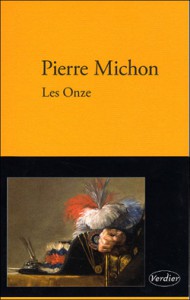
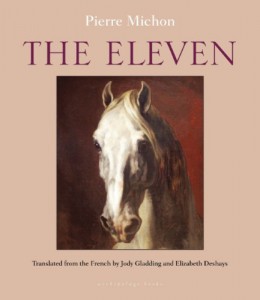 The museum guide who is the book’s narrator (addressing periodically his interlocutor as “Sir” –of course, also the reader) explains that nine of the eleven had been aspiring authors, mostly versifiers, or like Collot d’Herbois playwrights. The latter had written dozens of plays, and translated and performed Shakespeare (Macbeth would be used in the novel to describe these regicides). But for the narrator, they are all failed writers. Imbued with Enlightenment lingo that turned their native selfishness into compassion (their sincerity in chosing the party of humanity brought into question by their barbaric practices, especially in quelling provincial rebellions), they were part of a new generation that had declared itself independent of the old networks of patronage, insisting that their voice must be heard unfettered, because it mattered. Bénichou’s Le sacre de l’écrivain is here the inspiration. The reign of the priest was over and the future belonged to writers. “God had changed nests.” (p.34) The Revolution, however, gave them fame of an altogether different kind. This left them somewhat bewildered and uncertain about their achievement. In their youthful dabbling in letters, they resembled Corentin’s father, who left his wife and young son back in Combleux “upriver from Orléans” to try his luck as poet in Paris, dissipating the family fortune in the process. This leads the guide to suggest that Corentin painted eleven portraits of his own father. Still, these were parricides who had voted the king’s death, now become a ferocious band of brothers preying on each other. One is reminded of Lynn Hunt’s The Family Romance of the French Revolution.
The museum guide who is the book’s narrator (addressing periodically his interlocutor as “Sir” –of course, also the reader) explains that nine of the eleven had been aspiring authors, mostly versifiers, or like Collot d’Herbois playwrights. The latter had written dozens of plays, and translated and performed Shakespeare (Macbeth would be used in the novel to describe these regicides). But for the narrator, they are all failed writers. Imbued with Enlightenment lingo that turned their native selfishness into compassion (their sincerity in chosing the party of humanity brought into question by their barbaric practices, especially in quelling provincial rebellions), they were part of a new generation that had declared itself independent of the old networks of patronage, insisting that their voice must be heard unfettered, because it mattered. Bénichou’s Le sacre de l’écrivain is here the inspiration. The reign of the priest was over and the future belonged to writers. “God had changed nests.” (p.34) The Revolution, however, gave them fame of an altogether different kind. This left them somewhat bewildered and uncertain about their achievement. In their youthful dabbling in letters, they resembled Corentin’s father, who left his wife and young son back in Combleux “upriver from Orléans” to try his luck as poet in Paris, dissipating the family fortune in the process. This leads the guide to suggest that Corentin painted eleven portraits of his own father. Still, these were parricides who had voted the king’s death, now become a ferocious band of brothers preying on each other. One is reminded of Lynn Hunt’s The Family Romance of the French Revolution.
 The painter and the painting are, of course, complete fabrications, as are Michelet’s “famous pages.” The novel itself is short, a mere 97 pages in the English version, and was written in two stages. The first half completed in 1993 describes Corentin’s background, childhood, and youth. The second, finished in 2008, focuses on the dreary night of the commission and reflections on the Terror. In the first part, Michon had situated the “douceur de vivre” of the Old Regime (oddly translated as gentle living) within class differences. “Françoizélie,” as his mother and grandmother call him, is the product, on his maternal side, of the union of an engineer employed by Louvois to build the branch of the Loire canal between Montargis and Orléans, who also happens to be a Hughenot renegade. He marries into local impoverished nobility and lives long enough to give his bride a daughter, Suzanne, and to leave them a substantial fortune invested in trade and vineyards. Suzanne grows into a lovely young woman with heaving bosom, who frequents the Orléans literary salons where she meets her future husband, one of the countless petits abbés of the Old Regime with literary ambitions, who throws off his collar for her.
The painter and the painting are, of course, complete fabrications, as are Michelet’s “famous pages.” The novel itself is short, a mere 97 pages in the English version, and was written in two stages. The first half completed in 1993 describes Corentin’s background, childhood, and youth. The second, finished in 2008, focuses on the dreary night of the commission and reflections on the Terror. In the first part, Michon had situated the “douceur de vivre” of the Old Regime (oddly translated as gentle living) within class differences. “Françoizélie,” as his mother and grandmother call him, is the product, on his maternal side, of the union of an engineer employed by Louvois to build the branch of the Loire canal between Montargis and Orléans, who also happens to be a Hughenot renegade. He marries into local impoverished nobility and lives long enough to give his bride a daughter, Suzanne, and to leave them a substantial fortune invested in trade and vineyards. Suzanne grows into a lovely young woman with heaving bosom, who frequents the Orléans literary salons where she meets her future husband, one of the countless petits abbés of the Old Regime with literary ambitions, who throws off his collar for her.
 That abbé, François Corentin, was the son of a Limousin peasant-entrepreneur who hired gangs of desperate men to work in government projects, such as the canal, at starvation wages and in degrading conditions. He does well for himself and settles in Orléans as wine-seller and vinegar factory-owner who spikes his wine with beets to stretch it and then sells it to the poor devils. Thus, notes Michon, do the poor exploit the poor. The Limousins become the by-word for the oppressed.
That abbé, François Corentin, was the son of a Limousin peasant-entrepreneur who hired gangs of desperate men to work in government projects, such as the canal, at starvation wages and in degrading conditions. He does well for himself and settles in Orléans as wine-seller and vinegar factory-owner who spikes his wine with beets to stretch it and then sells it to the poor devils. Thus, notes Michon, do the poor exploit the poor. The Limousins become the by-word for the oppressed.
With his father fled to Paris, François-Élie grows up in the skirts of his loving mother and grandmother, whom he adores and torments in turn, in a sunny Rococo pastoral setting. Yet, one day, the ten-year-old runs to the canal to find it dry. It is time for the periodic clearing of the muck that settles at the bottom. Beneath the smooth surface of the water, lies the rotting, smelly underbelly of the famed douceur de vivre, with dead fish that the Limousin workers feed on, in the dreary cycle of their miserable lives. What, the boy asks, are these men doing? “They are remaking what your grandfather made the first time, says his mother. They are making the canal. Then the child, with great seriousness and annoyed at having to state the obvious: They are not making anything; they are working.” (p.48) For the young François Élie work is meaningless, only creation matters, as if his grandfather had conceived and built the canal by the force of his intellect rather than the blood and sweat of living men. When Michon remarks, through his narrator, that nothing creative has ever come out of the Limousin, “Because if the Limousins choose letters, letters do not choose the Limousins.” (p.34), I was reminded of Turgot’s sophomoric trompe-l’oeil, painted on his office door in Limoges, showing a bookcase titled Illustrious Limousin Authors lined with empty shelves.
At the canal site, one of the miserable laborers filling baskets of mud has somehow managed, through the mysterious workings of fate, to retain an amazingly handsome physique and he stares up at Suzanne’s naked body under her panier-dress with evident lust and she, abandoned by her husband, finds herself responding and flees. Corentin’s Oedipal relation to his mother (we might note he never marries) is encapsulated in his fleeting wish that she had been raped. The eighteenth-century’s Bernardin de Saint-Pierre and Rousseau maidens, we are reminded, are also the prey of Sade and his ilk. And the blackened men from the canal floor would soon be seeking their revenge, “fierce children with their great pikes.” (p.32)
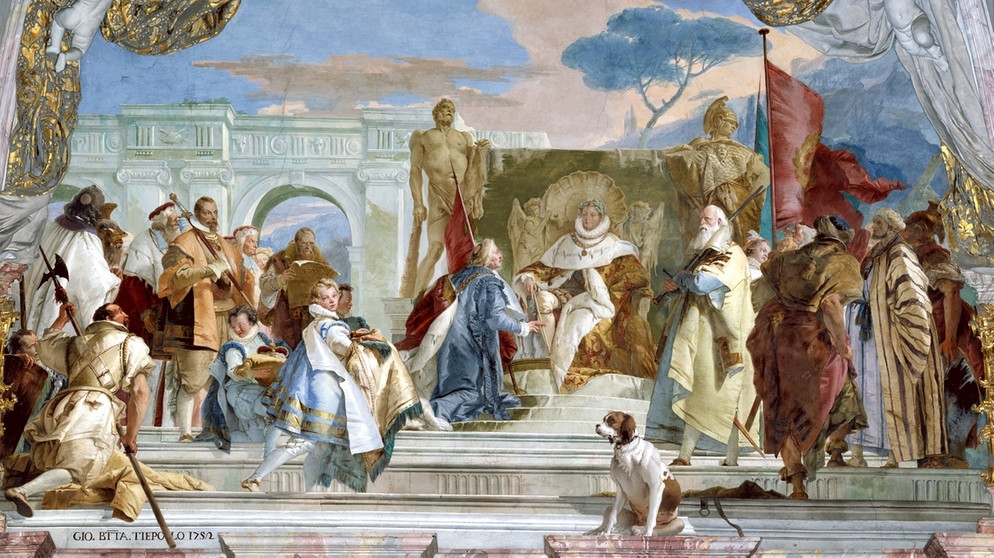 Corentin at 63, although disillusioned and bleak, is not a neo-classicist like David, but harks back to his training under Tiepolo, and through him, Veronese. Michon has explained that he sees him as a sort of Goya, the Goya of the Tres de Mayo.[1] Corentin was molded in the airy wonders of the Wurtzburg ceiling on which he worked as an apprentice for three years. It is even rumoured that he is the model of the blond young man carrying a crown on a pillow. This golden period extends Francois-Élie’s idyllic childhood. He subsequently makes a killing with a commission for the marquis de Marigny (Mme de Pompadour’s brother) [2] that allows him to purchase a house in Paris. He is not prolific but paints a series of Sibyls where, as final indignity, his mother and grandmother become models for the harpies. During the Revolution he works in David’s atelier “like every other painter.” He also is said to have designed the uniforms of the murderous commissioners on mission (actually, of course, David had) that would feature prominently in The Eleven as revolutionary symbols.The painting would earn him the title of the Tiepolo of the Terror.
Corentin at 63, although disillusioned and bleak, is not a neo-classicist like David, but harks back to his training under Tiepolo, and through him, Veronese. Michon has explained that he sees him as a sort of Goya, the Goya of the Tres de Mayo.[1] Corentin was molded in the airy wonders of the Wurtzburg ceiling on which he worked as an apprentice for three years. It is even rumoured that he is the model of the blond young man carrying a crown on a pillow. This golden period extends Francois-Élie’s idyllic childhood. He subsequently makes a killing with a commission for the marquis de Marigny (Mme de Pompadour’s brother) [2] that allows him to purchase a house in Paris. He is not prolific but paints a series of Sibyls where, as final indignity, his mother and grandmother become models for the harpies. During the Revolution he works in David’s atelier “like every other painter.” He also is said to have designed the uniforms of the murderous commissioners on mission (actually, of course, David had) that would feature prominently in The Eleven as revolutionary symbols.The painting would earn him the title of the Tiepolo of the Terror.
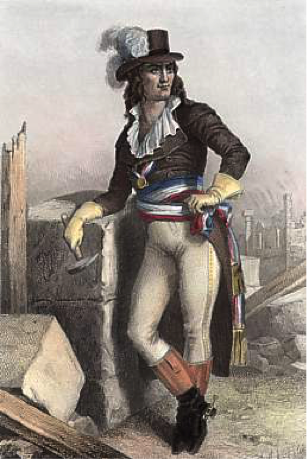
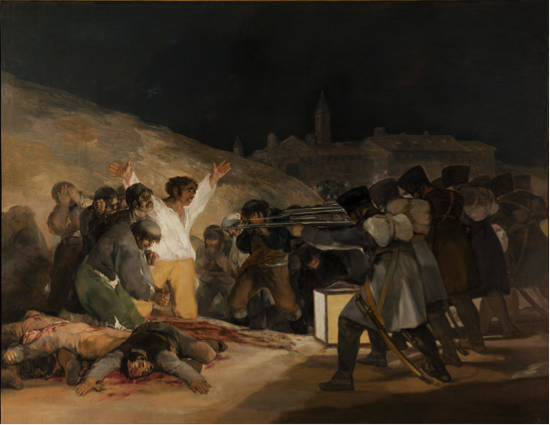 Michon offers snipet biographies of the eleven terrorists and depicts the onset of the Great Terror, although stressing that the painting represents Nivôse and not the decress of Ventôse, as has sometimes been claimed. He then moves to historical interpretations, asking why we are so fascinated with historical gore, so that the public presumes that the social context “can be picked up later.” Michon does not, however, address the context of the Terror. Rather he universalizes it. While The Eleven presents as well as represents History in the guise of the members of the Committee of Public Safety, this is but one image among many of violence and war. Thus the narrator brings up Ucello’s battle-scenes where horse and knight meld together in a bloody mess. This all harks back to the primal moment when horses were worshipped and feared. “This is Lascaux, Sir. The forces, the powers, the commissioners.”(p.97).
Michon offers snipet biographies of the eleven terrorists and depicts the onset of the Great Terror, although stressing that the painting represents Nivôse and not the decress of Ventôse, as has sometimes been claimed. He then moves to historical interpretations, asking why we are so fascinated with historical gore, so that the public presumes that the social context “can be picked up later.” Michon does not, however, address the context of the Terror. Rather he universalizes it. While The Eleven presents as well as represents History in the guise of the members of the Committee of Public Safety, this is but one image among many of violence and war. Thus the narrator brings up Ucello’s battle-scenes where horse and knight meld together in a bloody mess. This all harks back to the primal moment when horses were worshipped and feared. “This is Lascaux, Sir. The forces, the powers, the commissioners.”(p.97).
 Much has been written about Pierre Michon, on his allusions, his spare and evocative language, his fondness for vignettes.[3] The French text is magnificent and strong, and, although convoluted by moments, it is always enticing. When it won the Prix de l’Académie française in 2009, some reviewers suggeted that book’s popularity might be explained by its subject-matter and by its greater accessibility.[4] The English translation is too tame by moments but also easier to read, and admirable insofar as it must have been hell to translate. This turns it into a perfect text to teach. The bold fiction of the painting can be used alongside recent works on the Terror like Marisa Linton’s and Timothy Tacket’s. One can practically take every paragraph and turn it into an assignment: Old Regime social relations, the Enlightenment, misogyny, theatricality, historical representations, and, of course, the factions that vied for power in 1794 and the Terror itself. One can ask students to hunt down the allusions to education, sacrality, eighteenth-century literary and artistic trends, and have them ponder at how flawed mortals were able to alter the course of history. Reflections then on historical actors, but also on the writing of history. It is short but chock-full of “teachable moments.” It is a text best read in French but best taught in English.
Much has been written about Pierre Michon, on his allusions, his spare and evocative language, his fondness for vignettes.[3] The French text is magnificent and strong, and, although convoluted by moments, it is always enticing. When it won the Prix de l’Académie française in 2009, some reviewers suggeted that book’s popularity might be explained by its subject-matter and by its greater accessibility.[4] The English translation is too tame by moments but also easier to read, and admirable insofar as it must have been hell to translate. This turns it into a perfect text to teach. The bold fiction of the painting can be used alongside recent works on the Terror like Marisa Linton’s and Timothy Tacket’s. One can practically take every paragraph and turn it into an assignment: Old Regime social relations, the Enlightenment, misogyny, theatricality, historical representations, and, of course, the factions that vied for power in 1794 and the Terror itself. One can ask students to hunt down the allusions to education, sacrality, eighteenth-century literary and artistic trends, and have them ponder at how flawed mortals were able to alter the course of history. Reflections then on historical actors, but also on the writing of history. It is short but chock-full of “teachable moments.” It is a text best read in French but best taught in English.
Pierre Michon, Les Onze (Paris: Verdier, 2009) and The Eleven, translated by Jody Gladding and Elisabeth Deshays (Brooklyn, NY: Archipelago Books, 2013).
- Television interviews of Michon on the novel, at this link, and in conversation with historian Jean-Clément Martin, at this link.
- Mme de Pompadour is referred to as maman putain, the name given her by Louis XV’s children. Altogether women here are cyphers that express the late eighteenth-century’s denigration of their status.
- For example, Pierre Michon La lettre et son ombre, Actes du colloque de Cerisy-la-Salle, août 2009, edited by Pierre-Marc de Biasi, Agnès Castiglione et Dominique Viart (Paris: Gallimard, 2013). My favorite article is Manet Van Monfrans, “’Ivresse du minimal’ la poétique du paysage dans Les Onze de Pierre Michon,” pp.240-255.
- The book was reviewed by all major French newspapers and weeklies at its publication in fall 2009 and these reviews can be accessed on-line. See also the review in Annales historiques de la révolution française, 2009: 4, pp. 201-4. There are far fewer reviews of the English translation. See the review by Stephen Henighan who comments on the translation, at this link.